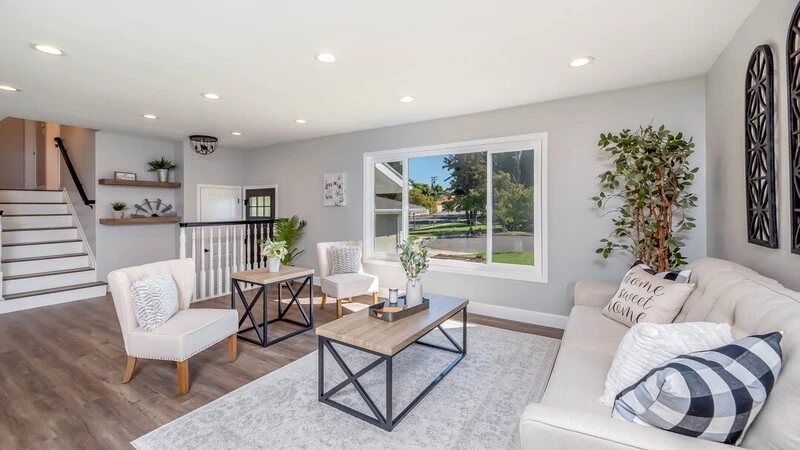Recessed can light, often called can lights or downlights, are popular for modern lighting in homes and commercial spaces. We install them into the ceiling, creating a clean, unobtrusive look. Here’s a comprehensive guide understanding these fixtures, their benefits, types, and how to install them.
What is a Recessed Can Light?
A recessed can light is a type of lighting fixture set into a hollow space in the ceiling. This design makes the light fixture almost flush with the ceiling, giving it a streamlined appearance. The main components of a recessed can light include:
- The Housing (or Can): This is the metal enclosure that holds the light bulb or LED. It’s installed into the ceiling cavity.
- The Trim: The trim is the part of the fixture that is visible from the room. It surrounds the bulb and is flush with the ceiling.
- The Light Source: This could be a traditional incandescent bulb, a compact fluorescent bulb (CFL), or an LED bulb.
Benefits of Recessed Can Lights
- Clean Look: One of the biggest advantages of recessed can lights is their sleek and modern appearance. Since we install them into the ceiling, they don’t take up visual space, making them ideal for minimalist or contemporary designs.
- Versatile Lighting: Recessed can lights are incredibly versatile. You can use them for general lighting to illuminate a whole room, task lighting to focus light on specific areas, or accent lighting to highlight artwork or architectural features.
- Space-Saving: Since these lights are installed into the ceiling, they don’t protrude into the room. This is particularly useful in rooms with low ceilings or limited space where traditional light fixtures might be obstructive.
- Even Distribution: Recessed can lights provide even lighting throughout the space. They help to reduce shadows and ensure that light is distributed consistently, which is great for areas where clear and uniform lighting is necessary.
- Reduced Glare: Because the light source is set back into the ceiling, recessed can lights help to minimize glare. This can make the lighting more comfortable, especially in spaces where bright, direct light might be bothersome.
Types of Recessed Can Lights
- Adjustable vs. Fixed:
- Adjustable: These lights can be tilted or rotated to direct light where it’s needed. They are perfect for highlighting specific areas or objects.
- Fixed: Fixed recessed can lights provide a stationary beam of light. They are often used for general illumination and don’t offer directional flexibility.
- LED vs. Traditional Bulbs:
- LED: LED bulbs are energy-efficient and have a long lifespan. They produce less heat and are available in various color temperatures, which allows for a range of lighting effects.
- Incandescent: Although we use incandescent bulbs less often due to their higher energy consumption, we still use them in some recessed fixtures. They provide a warm light but require more frequent replacement and are less energy-efficient.
- New Construction vs. Remodel:
- New Construction:
We design these for installation during the building’s construction, requiring a framing process and making them easier to install before finishing the ceiling. We design remodeled recessed can lights for installation in existing ceilings, allowing us to add them with minimal disruption.
- New Construction:
Installation Tips
- Plan Placement: Think about where you want to place your recessed can lights before installation. For even lighting, space the lights evenly across the ceiling. For focused lighting, adjust the placement according to your needs.
- Check Ceiling Insulation: Make sure the recessed can light you choose is rated for use in insulated ceilings if necessary. This will prevent overheating and ensure safety.
- Choose the Right Trim: The trim of the recessed can light affects both its look and functionality. Options include baffles (to reduce glare), reflectors (to increase brightness), and wall-wash trims (to wash walls with light).
- Consider Professional Help: If you’re not comfortable with electrical work or unsure about the installation process, it’s a good idea to hire a licensed electrician. They can ensure that the installation is done correctly and safely.
Conclusion
Recessed can lights are a fantastic option for anyone looking to achieve a modern, clean look with their lighting. They offer many benefits, including a sleek appearance, versatile lighting options, and space-saving design. By understanding the different types, benefits, and installation tips, you can make an informed choice about incorporating recessed can lights into your space. Whether you’re looking to enhance the ambiance of a room or provide functional lighting, these fixtures can meet a variety of needs while maintaining a stylish and uncluttered look. If you have any questions, please visit the Kaz World Mag.

